| Metro Transit | |
|---|---|
 | |
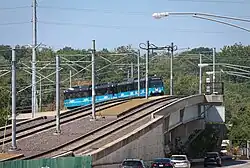 MetroLink approaching the Clayton station | |
| Overview | |
| Owner | Bi-State Development Agency |
| Locale | Greater St. Louis, Missouri–Illinois, U.S. |
| Transit type | Light rail Streetcar Bus Paratransit |
| Number of lines | 2 light rail lines 1 streetcar line 58 bus routes |
| Number of stations | 38 (Light rail) 10 (Streetcar) 9,000 (Bus) 25 (Transit centers) 26 (Park-Ride lots) |
| Daily ridership | 62,000 (weekdays, Q3 2023)[1] |
| Annual ridership | 19,049,100 (2022)[2] |
| Chief executive | Taulby Roach |
| Headquarters | One Metropolitan Square 211 North Broadway St. Louis, Missouri, 63102, U.S. |
| Website | metrostlouis.org |
| Operation | |
| Began operation | September 20, 1949 |
| Reporting marks | BSDA |
| Number of vehicles | 25 Siemens SD-400s 54 Siemens SD-460s 24 Electric buses 237 Diesel buses 123 Call-A-Ride vans 2 Gomaco Brill replica streetcars 1 MMTB W2-class streetcar |
Metro Transit is an enterprise of the Bi-State Development Agency and operates public transportation services in the St. Louis region. In 2022, the system served 19,049,100 passengers.
History
_a_-15_HODIAMONT_car._This_shot_was_taken_from_the_operator's_cab_of_PCC_car_-1615_waiting_on_the_Wellston_Loop_on_April_17%252C_1963_(22724465535).jpg.webp)
The enterprise known today as Metro Transit was founded in 1963 when the Bi-State Development Agency, using a $26.5 million bond issue, purchased and consolidated 15 privately owned transit operators to sustain efficient and reliable public transportation in the region.[3] These services would operate under the Bi-State name until 2003, when the agency would begin operating as Metro. In 2015, the Bi-State Development name would be resurrected for the parent organization and the public transit enterprise renamed Metro Transit.[4]
In the 1960s, after taking over the private operators, Bi-State consolidated bus lines and in 1966 shut down the St. Louis region's last streetcar service, the Hodiamont line. Its right-of-way was paved over and replaced with buses.
In the 1970s, the system became one of the first in the United States to use buses equipped with wheelchair lifts.[3]

In the 1980s, Metro Call-A-Ride began demand response service to help people whose physical or cognitive disabilities prevented them from independently using regular fixed-route bus or light rail service. In 1986, Arts in Transit, Inc. was founded, which is a 501(c)(3) organization that ensures the integration of local art and design in the transit system.[5] In 1987, the East-West Gateway Council of Governments completed a study that recommended light rail with an integrated bus network as the next step forward for the St. Louis region’s public transit system.[3]
Construction on the region's first light rail line began in 1990 by reusing former railroad rights-of-way including downtown subway tunnels and the Eads Bridge.[3] The first 13.9-mile (22.4 km) segment opened on July 31, 1993, between the North Hanley and 5th & Missouri stations. The remainder of this initial alignment was completed on June 25, 1994, when the extension to Lambert Airport Main opened. Three infill stations have been added to this original alignment. East Riverfront in 1994, Lambert Airport East in 1998, and Cortex in 2018.[6][7] In 2001, MetroLink doubled in length with a 17.4-mile (28.0 km) extension to Southwestern Illinois College in St. Clair County. Two years later, a 3.5-mile (5.6 km) extension brought service to Shiloh, Illinois.[6] In 2006, Metro opened the 8-mile (13 km) Cross County extension that runs from the Forest Park-DeBaliviere station to Shrewsbury, Missouri.[8]
After St. Louis County voters defeated Proposition M in 2008, Metro was forced to cut 24 Missouri bus routes in 2009.[9][3] Metro returned to voters in 2010 with Proposition A and was successful in raising additional funds for the system.[10] In 2019, the State of Illinois provided the St. Clair County Transit District (SCCTD) $96 million in funding to extend MetroLink from Shiloh-Scott to MidAmerica St. Louis Airport in Belleville, Illinois. SCCTD began construction on the extension in 2023; Metro is expected to begin operating it in 2025.[11][12] In 2021, Metro introduced the region's first electric buses: 40-foot and 60-foot articulated models.[13]
In February 2022, Metro Transit took over operation of the troubled Loop Trolley.[14] Six months later, East-West Gateway voted to provide $1.26 million to Metro for long-term operation of the trolley.[15] Currently, the trolley operates between April and October.[16]
In 2023, Bi-State's board approved a Memorandum of Understanding (MOU) authorizing the Bi-State and Metro teams to plan, design, and develop the Jefferson Alignment MetroLink Expansion project with the City of St. Louis.[17] Bi-State and Metro are also working with St. Louis County on an additional extension into North County.[18]
System
MetroBus

Since 1963, Metro Transit has continuously provided bus service in the Greater St. Louis region. Metro currently operates 46 fixed bus routes in Missouri and 12 fixed bus routes in Illinois.[19] In September 2019, Metro launched Metro Reimagined, a restructuring of Missouri bus routes to add increased frequency on busy routes but discontinued six low ridership routes.[20][21] In June 2021, Metro introduced the region's first electric buses including 40-foot and 60-foot articulated models. The 60-foot articulated buses are used exclusively on the #70 Grand bus line, the region's busiest.[13]
MetroLink

Since 1993, Metro Transit has operated light rail service in the Greater St. Louis region. Today, the system consists of two lines, the Red and Blue lines, with 38 stations and 46 miles (74 km) of track. It runs from St. Louis Lambert International Airport in northwest St. Louis County to Shiloh, Illinois near Scott Air Force Base in southeast St. Clair County. The Cross County extension opened in 2006 and introduced MetroLink service between Forest Park and Shrewsbury, Missouri. A 5.2-mile (8.4 km) extension of the Red Line from Shiloh-Scott to MidAmerica St. Louis Airport in Mascoutah broke ground in 2023 and is expected to be operational by 2025.[22][12] In Missouri, Metro and local leaders are planning a line that would run between North and South St. Louis with a potential extension into North St. Louis County.[23][18]
While officially light rail, MetroLink features many characteristics of a light metro or rapid transit service,[24] including a completely independent right of way, a higher top speed, and level boarding at all platforms.[25][26]
Metro Call-A-Ride
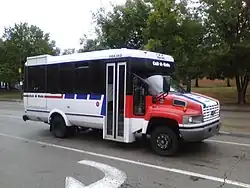
Since 1987, Metro Transit's Call-A-Ride demand response service has provided alternative transportation to residents who have limited access to MetroBus or MetroLink and/or disabled residents who are unable to use those services.[27] In April 2023, in response to operator shortages, Metro announced that it would reduce its service area for Call-A-Ride, primarily in southwest and far north St. Louis County. These reductions in service have led to significant criticism for the transit agency.[28][29]
Via Metro STL
Via Metro STL is an app based, on-demand public transport service provided by Via Transportation in partnership with Metro Transit. The service launched in June 2020 and provides rides in the outer regions of St. Louis County across three service zones; North, South and West.[30][31]
Loop Trolley

The Loop Trolley is a 2.2-mile (3.5 km), 10-station heritage streetcar line that runs from City Hall in University City to the Missouri History Museum in St. Louis' Forest Park. The line travels along Delmar Boulevard through the popular Delmar Loop district and DeBaliviere Avenue between Delmar and Forest Park. The trolley has stops at both the Forest Park-DeBaliviere and Delmar Loop MetroLink stations.
On February 18, 2022, Metro Transit's board voted to take over operation of the Loop Trolley after several financial setbacks and closures.[32] Metro reopened the Loop Trolley for operation on August 4, 2022.[33] On August 21, 2022, the East-West Gateway Council of Governments voted to award Metro a $1.26 million grant to operate the trolley for the next several years.[34] Currently the Loop Trolley operates on a seasonal schedule between April and October.[16]
Fleet
Buses
Metro Transit operates a total of 261 vehicles for MetroBus. 237 of them are made up of 35 and 40-foot low-emission, low-floor diesel buses made by Gillig. The rest make up Metro's battery-electric fleet and include 10 40-foot Gillig low-floor buses and 14 60-foot articulated New Flyer XE60 buses. Electric buses are charged overnight at the Brentwood and DeBaliviere garages, while in-service charging is at the North Broadway Transit Center.[13][19][35]
In addition to its bus fleet, Metro also operates 123 Call-A-Ride vans.[19]
Rail
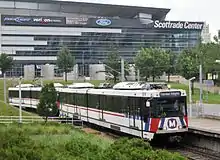
At its largest, Metro Transit operated a fleet of 87 Siemens light rail vehicles for MetroLink, including 31 SD-400 cars and 56 SD-460 cars.[36] As of 2023, Metro operated a total of 75 light rail vehicles.[19] Of the original 31 SD-400 cars, only 25 remain in service and two SD-460 cars were destroyed in a July 2022 flash flood.[37][38] Metro services trains at its Ewing and 29th Street rail yards.
In May 2023, Metro received a $196.2 million federal grant to purchase up to 48 Siemens S200 light rail vehicles to replace the remaining 25 SD-400 cars.[39][40] Meanwhile, Metro is refurbishing the remaining SD-460 cars for continued use. Delivery of the new vehicles is expected to begin in 2026.[41]
Metro currently operates three vehicles for the Loop Trolley. Two Gomaco-built Brill-replica streetcars that came from Portland, Oregon and one ex-Melbourne, Australia, W2-type streetcar that had been in use in Seattle.[42][43]
Liveries
Metro Transit has a similar livery across all of its services except its battery-electric buses and the Loop Trolley. In 2019, Metro began phasing in a new livery for its vehicles.[44] Previously, MetroLink vehicles had a white base with a red stripe running horizontally beneath the windows that turned into a dashed blue stripe near each operator cab. The front included Metro's "M" logo centered between vertical blue, red, and white lines. MetroBus and Metro Call-A-Ride were similar, except the red stripe continued around the rear of the vehicles.
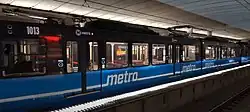
The new livery is made up of a blue base with white accents. On MetroLink, the stripe was moved further below the windows so the word "metro" could be inlaid within it and the tops of the cars were painted black. Metro Call-A-Ride uses this same design. MetroBus includes two large white circles on either side of the bus. The horizontal stripe has been eliminated, save for a small portion on either side of the word "metro." All three services retained Metro's "M" logo on the front of their vehicles.[44]
Metro's battery-electric buses are a shade of lime green on the front and rear with shades of blue in the center accented by a green leaf pattern. A white stripe runs horizontally near the base with the word "metro" and an image of a power plug inlaid within it. This livery is part of a partnership with Ameren Missouri.[45]
In January 2024, the agency announced that it would cease the sale of advertising that covers the exteriors of buses and trains for aesthetic reasons. The 144 exterior advertisements had generated up to $1.5 million annually through contractor Vector Media but were also the subject of complaints.[46]
Security
Security for the Metro system is provided by uniformed police and security officers. Security features in vehicles, stations and transit centers include lights, closed-circuit television monitoring, emergency telephones, police and security patrols, and radio communication between operators and MetroBus and MetroLink Central Control.[47]
Secure Platform Plan
In 2024, Metro Transit will begin adding turnstiles at all MetroLink stations as part of its $52 million Secure Platform Plan (SPP). Stations will also receive a new fare collection system, additional fencing, passenger assist telephones, and cameras monitored from a new real-time camera center.[48]
The SPP will be implemented in six phases of four to eight stations apiece. The first two phases are slated for completion in 2024 and the rest in 2025. The first phase covers four Illinois stations; the second, seven Missouri stations.[48] On September 26, 2023, Millstone Weber LLC was awarded a $6.4 million contract for the first phase with completion expected in spring 2024.[49]
Funding and leadership
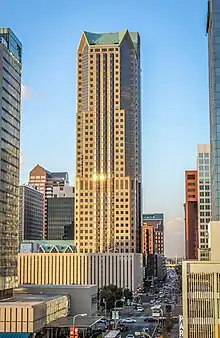
Metro Transit's operating budget is funded by sales taxes from the city of St. Louis and St. Louis County and the St. Clair County Transit District. Other funds come through federal and state grants and fare paying passengers.[50][51] Collectively, St. Louis City and County contribute 1.75% in sales tax to Metro, while St. Clair County, Illinois contributes 0.75%.
| Historical Sales Tax Ballot Initiatives | |||
|---|---|---|---|
| Date | County | Sales Tax | Result |
| November 1993 | St. Clair | 0.75% | Passed[52] |
| August 1994 | City of St. Louis | 0.25% | Passed |
| August 1994 | St. Louis | 0.25% | Passed |
| August 1996 | St. Charles | 0.5% | Failed |
| November 1996 | St. Charles | 0.5% | Failed |
| November 1997 | City of St. Louis | 0.25% | Passed[53] |
| November 1997 | St. Louis | 0.25% | Failed |
| November 1997 | Madison | 0.5% | Failed |
| November 2008 | St. Louis | 0.5% | Failed |
| April 2010 | St. Louis | 0.5% | Passed |
| April 2017 | City of St. Louis | 0.5% | Passed[54] |
Metro's executive leadership is made up of its President and CEO, Taulby Roach and its Chief Operating Officer, Charles A. Stewart. As an enterprise of the Bi-State Development Agency, Metro's leadership answers to Bi-State's Board of Commissioners.[55]
Projects in progress
MidAmerica Airport
In 2019, the St. Clair County Transit District was awarded $96 million in Illinois infrastructure funding to build a 5.2-mile (8.4 km) extension of the Red Line from Shiloh-Scott to MidAmerica St. Louis Airport in Mascoutah.[56] This extension will include two 2.6-mile (4.2 km) segments, a double-track and a single-track segment, along with a station at the airport.[57] Construction on the expansion began in 2023 with Metro expecting to begin operations in 2025.[58][12]
Infrastructure Improvements
In 2023, Metro began a system-wide rehabilitation program that will last up to two years.[59] That spring, Metro began rehabilitating the downtown subway tunnels, including the Laclede's Landing, Convention Center and 8th & Pine subway stations.[60] Elsewhere, curve tracks, catenary wire, system conduit, staircases and retaining walls are to be upgraded or replaced.[61] Three stations are to receive platform rehabilitations: Jackie Joyner-Kersee Center, Rock Road and Wellston.[61]
Beginning in 2024, Metro will start rehabilitating the Union Station tunnel in addition to the Cross County tunnels and stations between Forsyth and Skinker. The latter will include the construction of a storage siding near the Richmond Heights station.[61] In 2024, Metro expects to complete upgrades to the Supervisory Control Automated Data Acquisition (SCADA) and Public Address/Customer Information (PA/CIS) systems. The upgraded SCADA/PA/CIS will operate as an integrated system that monitors and controls operations and will allow Metro to provide real-time arrival information to passengers, such as live displays at stations.[61]
Projects in planning
North-South MetroLink
Northside/Southside - St. Louis City
- This 5.6-mile (9.0 km) expansion would serve approximately 14 stations between Chippewa Street in South St. Louis and Grand Boulevard in North St. Louis running primarily on Jefferson Avenue. Proposed frequency is 10 to 20 minutes operating between 5 a.m. and 1 a.m., 7 days a week. It would provide a fixed rail upgrade to Metro's high-volume #11 (Chippewa) and #4 (Natural Bridge) bus routes.[62] On September 22, 2023, Bi-State Development's board recommended for approval a 4-year, $18.9 million contract with the joint venture Northside-Southside Transit Partners to provide consulting services for the design phase of the project.[63]
St. Louis County Connector
- This extension would be a Phase II to Northside/Southside and continue from the North Grand station along Natural Bridge Avenue toward North St. Louis County. Higher-volume bus stops further west along Metro's #4 bus route support further expansion into North County.[64] In February 2023, Metro announced four routes for consideration with an LPA expected to be selected in the fall of 2023.[65]
The North-South corridor will not feature the rapid transit like characteristics of the Red and Blue lines but will be similar to other on-street light rail lines in the US, such as Houston or Phoenix, and would be separate from the rest of the system.[66] Because of this, an infill station to facilitate transfers will be constructed on the Red and Blue Lines where they intersect with the new Jefferson Avenue alignment.[67]
Previous proposals
Many of these services were proposed in 2010 when Metro Transit released its 30-year long range plan, Moving Transit Forward.[68] Most are defunct as regional leadership has said their priorities are the proposed MetroLink extensions in the city of St. Louis and North St. Louis County.[69]
MetroLink
Moving Transit Forward identified six potential MetroLink extensions as part of its long range plan: North-South, Clayton to Westport, MetroSouth, MetroNorth, Madison County and St. Charles County.[70] None ever moved passed the study phase due to several factors including funding, ridership potential, and community support.[71][72][73]
Bus Rapid Transit
Moving Transit Forward also identified five potential bus rapid transit lines. Four would have been freeway running lines between downtown St. Louis and its suburbs: I-44 to Eureka, I-64 to Chesterfield, I-55 to South County and I-70 to St. Charles County. A fifth line would have ran along Grand Boulevard in St. Louis.[70]
Commuter Rail
Initially, two long-distance commuter rail lines were proposed as part of Moving Transit Forward. Both lines would have run from the Gateway Transportation Center in downtown St. Louis to Alton, Illinois and the Pacific, Missouri area.[70] Both routes carry existing Amtrak service, however, neither route has been studied for local commuter rail service.
See also
- Bi-State Development Agency
- Madison County Transit
- MetroLink Blue Line
- MetroLink Red Line
- St. Clair County Transit District
- List of MetroLink (St. Louis) stations
- List of Metro Transit (St. Louis) yards and depots
- List of rail transit systems in the US
- List of rapid transit systems
- List of tram and light-rail transit systems
References
- ↑ "Transit Ridership Report Third Quarter 2023" (PDF). American Public Transportation Association. November 30, 2023. Retrieved December 6, 2023.
- ↑ "Transit Ridership Report Fourth Quarter 2022" (PDF). American Public Transportation Association. March 1, 2023. Retrieved March 29, 2023.
- 1 2 3 4 5 "History". Metro Transit – Saint Louis. Retrieved September 14, 2023.
- ↑ Jerry (August 14, 2015). "Bi-State Development Reaffirms its Unique Role With an Updated Look". Metro Transit – Saint Louis. Retrieved September 14, 2023.
- ↑ "About". Arts in Transit, Inc. Retrieved September 12, 2023.
- 1 2 "UrbanRail.Net > North America > USA > Missouri > St. Louis Metrolink". www.urbanrail.net. Retrieved September 14, 2023.
- ↑ "Soon-to-open Cortex MetroLink Station is more than just another stop, say regional transit leaders". STLPR. Retrieved September 14, 2023.
- ↑ "St. Louis Metro to Launch MetroLink Extension August 26". February 2, 2017. Archived from the original on February 2, 2017. Retrieved September 14, 2023.
- ↑ Flinchpaugh, Brian (November 11, 2008). "Transit users ponder future after Prop M's failure". STLtoday.com. Retrieved September 14, 2023.
- ↑ "Major Endorsement from St. Louis Voters for Transit Improvements". The Transport Politic. April 7, 2010. Retrieved September 14, 2023.
- ↑ Schlinkmann, Mark (June 14, 2019). "Illinois to pay for long-sought MetroLink extension to MidAmerica Airport". STLtoday.com. Retrieved September 12, 2023.
- 1 2 3 Cella, Kim (November 1, 2023). "Construction Underway on MetroLink Extension Project in St. Clair County". St. Clair County Transit District. Retrieved November 7, 2023.
- 1 2 3 Lindsey (June 29, 2022). "Celebrating 1 Year of Electric Buses". Metro Transit – Saint Louis. Retrieved September 18, 2023.
- ↑ Schlinkmann, Mark (February 19, 2022). "Bi-State board agrees to take over, restart Loop Trolley". STLtoday.com. Retrieved September 12, 2023.
- ↑ Schlinkmann, Mark (September 1, 2022). "Loop Trolley to get $1.26 million after regional board approves federal grant". STLtoday.com. Retrieved September 12, 2023.
- 1 2 "STL Loop Trolley". STL Loop Trolley. Retrieved September 12, 2023.
- ↑ Vallely, Jerry (March 24, 2023). "Memorandum of Understanding Approved for Bi-State Development Team to Plan, Design and Develop Jefferson Alignment MetroLink Expansion". BSD. Retrieved September 12, 2023.
- 1 2 Schlinkmann, Mark (February 18, 2023). "Bi-State reveals possible North County MetroLink routes". STLtoday.com. Retrieved September 12, 2023.
- 1 2 3 4 "System Profile". Metro Transit – Saint Louis. Retrieved September 14, 2023.
- ↑ "New MetroBus Service Plan". Metrostlouis.org Site. Retrieved January 24, 2020.
- ↑ "Metro Finalizes Plan To Overhaul Bus Service In Missouri; Rollout In September". STLPR. Retrieved September 15, 2023.
- ↑ Menn, Mackenzie (November 21, 2022). "MetroLink Expansion in Illinois is on Track". St. Clair County Transit District. Retrieved January 30, 2023.
- ↑ Vallely, Jerry (June 10, 2022). "Northside-Southside MetroLink Corridor Study Agreement Approved". BSD. Retrieved September 11, 2022.
- ↑ Track Design Handbook for Light Rail Transit. Transportation Research Board. 2012. ISBN 978-0-309-25824-1.
- ↑ "Joint International Light Rail Conference" (PDF). Onlinepubs.trb.org. p. 671. Retrieved July 25, 2022.
- ↑ Henry, Lyndon (2006). Sharing of Rail Transit Infrastructure by Streetcars and Larger Light Rail Vehicles: Design and Operational Issues. ISBN 978-1-931594-23-3.
- ↑ "Metro Call-A-Ride". Metro Transit – Saint Louis. Retrieved September 15, 2023.
- ↑ Schrappen, Colleen (September 17, 2023). "Call-A-Ride's struggles leave disabled St. Louis-area passengers in the lurch". STLtoday.com. Retrieved September 18, 2023.
- ↑ Stefanescu, Victor (June 22, 2023). "Call-A-Ride riders say service cuts hurt, ask Metro to rethink St. Louis-area's plan". STLtoday.com. Retrieved September 18, 2023.
- ↑ "Via Metro STL". Metro Transit – Saint Louis. Retrieved September 17, 2023.
- ↑ Lindsey (June 29, 2022). "Via Metro STL Celebrates 2 Years of Service". Metro Transit – Saint Louis. Retrieved September 17, 2023.
- ↑ Schlinkmann, Mark. "Bi-State board agrees to take over, restart Loop Trolley". STLtoday.com. Retrieved September 20, 2022.
- ↑ Schlinkmann, Mark. "Loop Trolley set to resume service Thursday morning after years shut down". STLtoday.com. Retrieved September 20, 2022.
- ↑ Schlinkmann, Mark. "Loop Trolley to get $1.26 million after regional board approves federal grant". STLtoday.com. Retrieved September 20, 2022.
- ↑ Lindsey (March 23, 2022). "Metro Transit Awarded $4M Grant to Expand Electric Bus Program". Metro Transit – Saint Louis. Retrieved October 16, 2023.
- ↑ "Siemens AG - Projects". February 7, 2007. Archived from the original on February 7, 2007. Retrieved October 16, 2023.
- ↑ Thomas, Jasmine (May 5, 2023). "Metro Transit Awarded $196.2 Million Federal Grant for New MetroLink Train Cars". Metro Transit – Saint Louis. Retrieved October 16, 2023.
- ↑ Lindsey (August 16, 2022). "MetroLink Flood Damage Update". Metro Transit – Saint Louis. Retrieved October 16, 2023.
- ↑ Thomas, Jasmine (May 5, 2023). "Metro Transit Awarded $196.2 Million Federal Grant for New MetroLink Train Cars". Metro Transit – Saint Louis. Retrieved October 16, 2023.
- ↑ Schlinkmann, Mark (May 5, 2023). "Feds give Metro $196 million grant for new MetroLink cars". STLtoday.com. Retrieved May 17, 2023.
- ↑ Stritzel, Chris (October 9, 2023). "New MetroLink Railcars Aim to Provide a Better Passenger Experience". CityScene STL. Retrieved October 16, 2023.
- ↑ "TriMet sells heritage trolleys to St. Louis". Railway Age. December 13, 2013. Retrieved October 16, 2023.
- ↑ "Seattle's old waterfront streetcars will live on - in different ways". January 25, 2016. Archived from the original on January 25, 2016. Retrieved October 16, 2023.
- 1 2 Vallely, Jerry (December 13, 2019). "A New Look for Metro Transit Vehicles". Metro Transit. Retrieved October 16, 2023.
- ↑ "Electric Buses". Metro Transit – Saint Louis. Retrieved October 16, 2023.
- ↑ Schlinkmann, Mark (January 4, 2024). "Metro yanks ads on buses, train cars. They're not 'aesthetically pleasing.'". St. Louis Post-Dispatch. Retrieved January 4, 2024.
- ↑ "Safety & Security". Metro Transit – Saint Louis. Retrieved September 15, 2023.
- 1 2 "Secure Platform Plan Project". Metro Transit – Saint Louis. Retrieved September 15, 2023.
- ↑ Jerry (September 26, 2023). "Contract Awarded for First Construction Package of MetroLink's Secure Platform Plan". Metro Transit – Saint Louis. Retrieved September 26, 2023.
- ↑ Agency Overview Archived September 24, 2010, at the Wayback Machine
- ↑ "Bi-State Development Agency of the Missouri-Illinois Metropolitan District, d.b.a.(St. Louis) Metro" (PDF). National Transit Database Agency Profiles. Federal Transit Administration. Retrieved May 29, 2018.
- ↑ "About". St. Clair County Transit District. Retrieved September 17, 2023.
- ↑ The 1997 Proposition M in St. Louis City was dependent on the passage of a similar proposition in St. Louis County. Consequently, the sales tax was not collected until St. Louis County passed Proposition A in 2010.
- ↑ Faulk, Mike (April 4, 2017). "MetroLink yes, soccer stadium no, and a win for St. Louis County police". STLtoday.com. Retrieved September 17, 2023.
- ↑ "Leadership". Metro Transit – Saint Louis. Retrieved October 24, 2023.
- ↑ Schlinkmann, Mark. "Illinois to pay for long-sought MetroLink extension to MidAmerica Airport". STLtoday.com. Retrieved September 20, 2022.
- ↑ "Trajectory for Transit in 2022 Points to Need for Continued Collaboration". January 19, 2022. Retrieved February 2, 2022.
- ↑ "When will MetroLink extension to MidAmerica Airport be complete? How much will it cost? - MidAmerica St. Louis Airport (BLV) | Mascoutah, IL". flymidamerica.com. July 14, 2021. Retrieved September 20, 2022.
- ↑ "MetroLink Improvements". Metro Transit – Saint Louis. Retrieved September 26, 2023.
- ↑ "Transit Infrastructure Improvements". Metro Transit – Saint Louis. Retrieved September 26, 2023.
- 1 2 3 4 "MetroLink Improvement Projects". Metro Transit – Saint Louis. Retrieved September 26, 2023.
- ↑ "Northside-Southside TAA" (PDF). East-West Gateway Council of Governments. Aecom.
- ↑ "Board of Commissioners 9/22/23" (PDF). Bi-State Development Agency. pp. 196–197. Retrieved September 26, 2023.
- ↑ "Northside-Southside TAA" (PDF). East-West Gateway Council of Governments. Aecom.
- ↑ Schlinkmann, Mark (February 18, 2023). "Bi-State reveals possible North County MetroLink routes". STLtoday.com. Retrieved September 12, 2023.
- ↑ "Claiming It Would "Divide Us", Stenger Opposes North-South Rail Transit – NextSTL". June 20, 2016.
- ↑ "Northside-Southside TAA" (PDF). East-West Gateway Council of Governments. Aecom.
- ↑ "Moving Transit Forward" (PDF). Metro Transit.
- ↑ Schlinkmann, Mark. "St. Louis County back in picture for north-south MetroLink expansion". STLtoday.com. Retrieved September 11, 2022.
- 1 2 3 "Moving Transit Forward" (PDF). Metro Transit. p. 37. Retrieved September 25, 2023.
- ↑ "East-West Gateway Board Defers Selection of MetroLink Alternative for Metro South Study Area" (PDF). East-West Gateway. November 3, 2004. Archived from the original (PDF) on May 15, 2013. Retrieved September 29, 2010.
- ↑ "Madison County Light Rail Feasibility Study Final Report" (PDF). East-West Gateway Council of Governments. pp. ES-5–ES-7. Retrieved September 25, 2023.
- ↑ Uptergrove, Kate. "St. Louis County to explore MetroLink expansion; St. Charles County says no". MidRiversNewsMagazine.com. Retrieved September 25, 2022.
External links
- Metro – Official website for Metro Transit
- Bi-State Development – Official website for Bi-State Development
- St. Clair County Transit District – Official website for the St. Clair County Transit District
- Citizens for Modern Transit – St. Louis transit advocacy group
- Arts in Transit Website